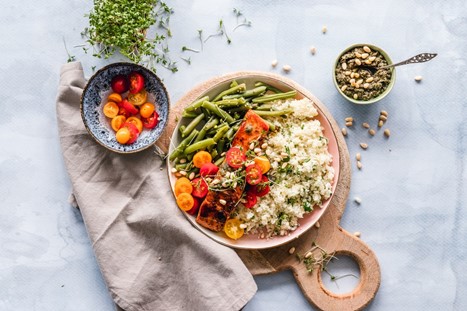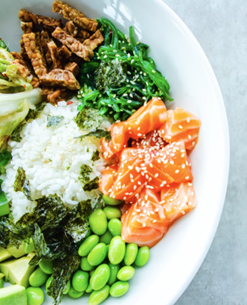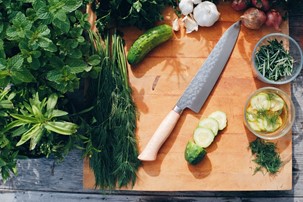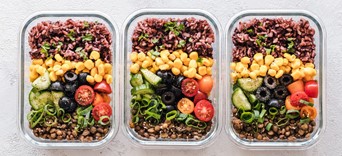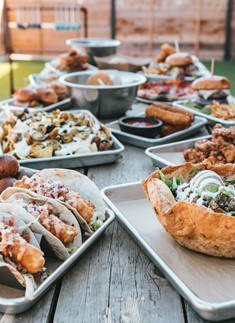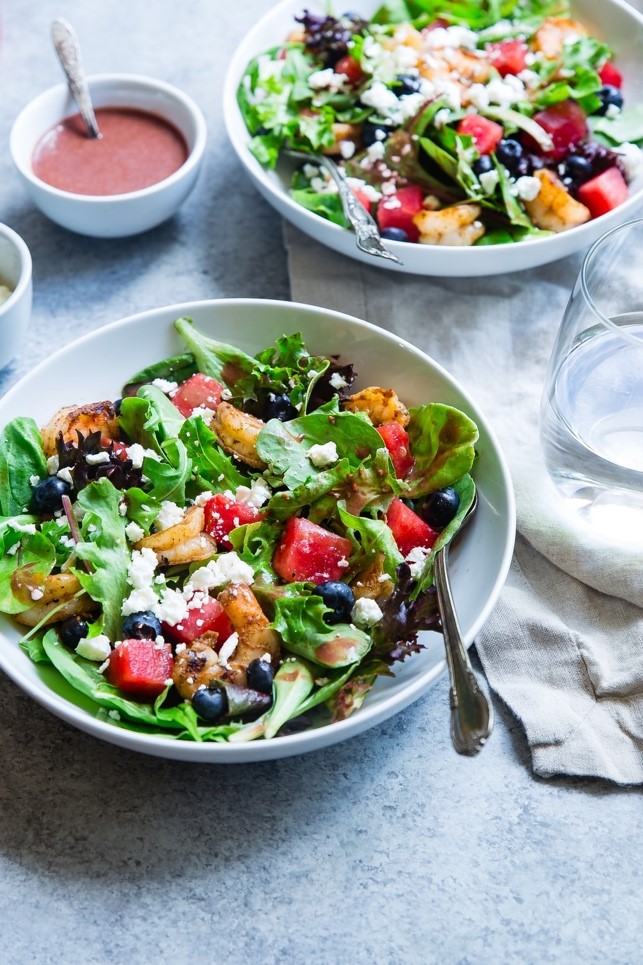Written by Stephanie Beechler, MPH, UNC-CH Dietetic Intern at Carolina Meadows
Why Nutrition Matters
It’s commonly understood that poor eating habits can have effects like weight gain and obesity, but studies have also indicated an unhealthy diet can contribute to the development of many other diseases, like cardiovascular disease and cancer, and can even affect brain health.1 Adopting good nutrition habits is an important part of both preventing and treating many health issues. Eating healthier usually means fewer meals out and spending a little more time in the kitchen. When your schedule is tight, this can seem daunting and many people feel like they just don’t have time to focus on proper nutrition. The truth is, improved eating habits do not have to be time consuming or overwhelming. The first step is to cultivate a mindset that prioritizes and values the impact of a healthy food choices. Then it’s just a matter of adopting some easy practices and habit changes that help fit nutritious foods into any lifestyle.
What Does it Mean to Eat Healthy?
Healthy eating generally means a balanced diet with a variety of whole foods and a range of flavors and textures to provide an array of nutrients, while avoiding boredom of repetitive meals. Focusing on whole foods and limiting processed foods also helps to reduce added sugar, saturated fat, and trans fat, which are commonly found in foods like processed meats and snacks, fried foods, and desserts. That being said, it’s important to remember everything is okay in moderation and no food needs to be completely avoided if you enjoy it and have no allergies or intolerances to it. Try to balance most meals and snacks to include protein, healthy fats, carbohydrates, and fiber. One way to visualize this is to prepare your plate with ½ non-starchy veggies, ¼ carbohydrates, and ¼ protein. Healthy fat is often found within the protein source or the oil used for cooking. Here are some nutritious sources of each:
- Protein: poultry, fish, shellfish, eggs, beef, pork, lamb, dairy, beans, nuts, seeds, whole grains, and soy products (i.e., tofu, tempeh, edamame, soy milk)
- Healthy Fat: nuts, seeds, avocado, olive oil, fatty fish (i.e., salmon, sardines)
- Carbohydrates: fruit, starchy vegetables (i.e., potatoes, sweet potatoes), whole grains
- Fiber: leafy greens, non-starchy vegetables, beans, whole grains, nuts, seeds
- Aim for 2-3 servings of non-starchy veggies per day
Eating regularly and pairing high-carb foods with foods higher in protein and fiber also helps to regulate blood sugar and increase satiety to keep us full for longer. Additionally, ensuring adequate hydration is essential to good health, keeping in mind hydration needs increase with exercise and time spent outdoors (especially in hot weather). All drinks (not just water) and foods such as juicy fruits, smoothies, and soups are all sources of hydration. Getting in the habit of having something to drink with meals and snacks, as well as bringing a water bottle to work and the gym can help with meeting hydration needs.
Make a Plan & Utilize Your Weekends
The first step to implementing a healthy diet is to plan. This doesn’t have to take long! Set aside just 20 minutes on the weekend to plan your breakfast, lunch, and dinner for the following week, as well as some healthy snacks to have on-hand for when hunger hits between meals. Use the recipes you’ve chosen to make a grocery list before you shop and order online to save time if your local store offers grocery pick-up or delivery. Making a full grocery list ensures nothing is forgotten and can reduce food waste by helping you shop for the exact amount you need of each item. You can even buy some healthier pre-made or frozen meals, looking for options that are lower in added sugar, saturated fat, and sodium. Additionally, keep a list of your favorite easy healthy recipes and snacks so you can refer back to them and save time meal planning in the future.
Using your free time to make a menu plan, grocery shop, and do some meal prep can really help to set you up for success during a busy week. Meal prepping on the weekend is a great option to minimize the amount of time in the kitchen during the week. Entire meals can be made ahead of time and kept in the fridge to eat over the next few days or they can be frozen for later in the week. Just place a frozen meal in the refrigerator to thaw about 2 days before you’re ready to eat it. Keep in mind some foods freeze better than others such as cooked vegetables, meats, chili, soups, stir-fries, and pasta sauces. Avoid freezing produce you plan to eat raw, as it will not be as crisp once thawed. On weekends with extra free time, meals can be made and frozen for future weeks when you need a quick last-minute heathy option. Search online for “Healthy Freezer Meals” for some recipe inspiration.
If you don’t want to make entire meals on the weekend, ingredients like vegetables can be at least cut and stored in the refrigerator to minimize prep-time when cooking during the week. Wait to wash delicate produce such as leafy greens and berries. Finally, it can be very helpful to use your free time to prepare some healthy snacks. Waiting until hunger hits often leads to quick, easy, and less nutritious choices if healthier options aren’t readily available.
Minimize Your Prep
There are a number of ways to minimize the amount of time spent meal prepping. Take advantage of pre-cut and pre-cooked ingredients such as vegetables and proteins like rotisserie chicken, canned fish, deli meats, and shrimp. These items tend to be more expensive, but can make good options for those particularly busy weeks. In contrast, canned and frozen ingredients are typically more affordable and make great choices as well. Canned foods are very convenient and many have low-sodium options available or foods like canned beans can be rinsed if sodium is a concern. Frozen produce is typically just-as or even healthier than fresh produce, since it’s frozen at peak freshness when nutrients are at their optimal levels. They also are cheaper and take much longer to go bad, which can minimize food waste. Just keep in mind frozen vegetables may be best for cooked dishes, since they are not as crisp as fresh vegetables once thawed. Microwave-ready ingredients can also cut down on cooking time, such as steam-in-bag vegetables and rice. Finally, take advantage of pre-made sauces, seasonings, and dressings to easily add flavor to your meals. Look for options lower in added sugar, sodium, and saturated fat.
Another way to reduce prep time is to practice batch cooking, which basically means making a large amount of a food at once and storing it for later. Preparing bigger batches means cooking less often because one night’s dinner can easily turn into lunch for the next few days. You can do this by doubling your favorite recipes and even freezing some servings for later.
Busy Mornings
Mornings tend to be the most time-crunched as we try to get out the door quickly, often sacrificing a nutritious breakfast and forgetting to pack food for the day. Just as the weekend is utilized for the weekday rush, a few minutes in the evening can be dedicated to setting yourself up for success in the morning. The night before, pack up your meals in containers or jars, fill a water bottle, and portion out some snacks to take with you the next day. This way, you can just grab a cooler and fill it with the already-prepared meals on your way out the door. You can even set up your coffee machine and have an easy make-ahead or quick-prep breakfast ready to go. Make-ahead breakfasts include meals like overnight oats and egg & veggie bakes. Overnight oats are simply oats soaked overnight with milk (dairy or non-dairy) and topped with your favorite toppings like nuts and fresh fruit. Egg bakes are basically scrambled eggs baked into a casserole dish or muffin cups. They’re very versatile, allowing you to use whatever mix-ins you prefer, and can be quickly heated in the morning for breakfast. Some quick-prep breakfasts include smoothies and soft-boiled eggs (made ahead of time) with avocado toast or fresh fruit.
General Tips
The most important tip to making healthy eating habits sustainable and realistic is to keep it simple! There is no need to overcomplicate a nutritious meal and there are tons of basic recipes out there to help. Look for recipes that use just one method of cooking – i.e., one-sheet, -pot, or -pan meals. Slow- and pressure-cooker meals are also usually one-pot recipes with the added benefit of “setting it and forgetting it” where you add all ingredients to the pot, then the meal is cooked without any additional work. Minimal to no-prep meals make great choices as well. For example, a salad with a pre-cooked protein (i.e., rotisserie chicken, hard-boiled eggs, canned fish, canned chickpeas) or a quick-cook protein (i.e., seasoned or marinated baked chicken or fish). Save time and effort by adding lots of flavor to your meal with easy herb/spice mixes or marinades and remember nutritious meals don’t always have to follow a norm. For example, breakfast is one of the easiest meals to make and a veggie omelet for dinner is a great option on a busy night. You can also try a “snack meal,” including a variety textures and flavors for satisfaction. Snack meal foods are those that are often thought of as snack items, but when paired and eaten in appropriate portion sizes can contribute the calories and nutrients of a meal. Some snack meal foods include nuts, deli meat, cheese, sliced vegetables, fruit, hummus, crackers, and hard-boiled eggs.
Practicing mindful eating whenever you do have your meals and snacks can be helpful in feeling more satisfied, eating appropriate portion sizes for your body, and truly appreciating food. For example, avoid multitasking when eating by taking a work break and stepping away from the phone, television, or computer for the duration of your meal or snack. Eat and chew slowly while focusing on experiencing the food with all of your senses. Notice the taste, smell, appearance, and texture as you eat. Practices like these allow us to connect to the body’s hunger and fullness signals, which can help reduce overeating, boredom snacking, and emotional eating.
Eating Out
It’s important to note that a healthy diet still allows for eating some meals out. After all, food is much more than just nutrients and is often the center of experiences, social events, and bringing friends and family together! Thankfully, most food facilities and restaurants have enough options to support forming a balanced meal. Try to create your plate as described previously with including sources of protein, healthy fat, carbohydrates, and fiber. Choose nutrient-dense foods such as lean proteins, whole grains, and vegetables. For example, a grilled chicken salad or salmon with potatoes and asparagus would make great options. It’s important to note that restaurant servings are often larger than most individuals need in a meal, so adjusting the portions as needed can be helpful. This can be done by saving some of the meal for later, sharing with others, or asking for smaller portions when ordering. Finally, dessert can be considered the carbohydrate component of a balanced meal. Pair it with a main dish higher in protein and non-starchy vegetables, and lower in carbohydrates. You can also share the dessert or save half for later.
Change is Possible!
As you can see, healthier nutrition habits are doable no matter your schedule! If you’re interested in including healthier meals in your diet, start by focusing on one meal at a time. Consider which meal you struggle the most with making nutritious choices, then set a goal to implement 1-2 of the suggestions described above for that meal. Over time, the changes will become more habitual and you can start to use more strategies and focus on any other meals you feel could be improved. Remember not to make too many changes at once! Making small, realistic, achievable changes over time is key to building sustainable habit change leading to long-term success.
Easy Healthy Meal Ideas
Breakfast:
- Yogurt + granola, fruit, nuts
- Overnight oatmeal + nut butter, fruit
- Egg bake / muffins
- Protein banana bread / muffins
- Baked oatmeal / cups
- Eggs + fruit or avocado toast
- Smoothie (fruit, veggies, nuts/seeds, optional protein powder)
Lunch:
- Salad + minimal/no-cook protein:
- Rotisserie chicken
- Hard-boiled eggs
- Canned tuna/salmon
- Deli meats
- Tofu, tempeh
- Beans/legumes
- Baked chicken or fish
- Sandwich + side salad
- Leftover dinner
Dinner:
- One-sheet pan meal: i.e., seasoned salmon, sweet potato, broccoli
- One-pot meal: i.e., chili, soups, beef pasta sauce + side salad
- One-pan meal: i.e., stir-fry with a protein (chicken, fish, tofu), chopped veggies, rice
- Slow-/pressure-cooker meals: i.e., pot roast w/ carrots & couscous
- Baked protein + sauteed veggie + starch
- I.e., roasted chicken, creamed spinach, quinoa
Snacks:
- Banana + nut butter
- Apple + nuts
- Hummus + chips and/or sliced veggies
- Popcorn + nuts and/or dark chocolate
- Homemade trail mix – nuts, raisins, dark chocolate chips
- Beef, turkey, or salmon jerky
- Homemade energy bites
- Hard-boiled eggs
- Turkey & cheese roll-ups
- Cottage cheese + peaches
- Chia pudding + berries
References:
1. https://www.uab.edu/inquiro/issues/past-issues/volume-9/82-the-effects-of-an-american-diet-on-health

